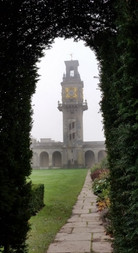Foggy day at Cliveden and Mistletoe
- Clare
- Dec 13, 2020
- 4 min read
Updated: Dec 16, 2020
It's great to get a change of scenery sometimes and I spent a few hours with two lovely friends exploring the grounds of Cliveden House in Buckinghamshire this week. The views were partially obscured by thick fog but the cold weather also meant it was reasonably quiet and therefore, at times, it felt we were the only ones there.
Cliveden House has a rich and decadent history. First built in the 1660s (when the estate was known as Cliff-dene), the house has suffered two major fires. The present house, which is now a luxury hotel (yes, you can actually stay there!), was largely built in the 1850s and owes its style to the architect Sir Charles Barry, who also designed the Palace of Westminster. Purchased by the wealthy Astor family in 1893, Cliveden was the scene of many lavish parties during the first half of the twentieth century, when the guest list included such notable figures as Gandhi, Henry Ford, George Bernard Shaw, Charlie Chaplin and a number of world leaders. It has also suffered scandal several times in its history, from the duel fought between the Duke of Buckingham and the Earl of Shrewsbury in 1668, to the part it played in the Profumo affair of the 1960s (it was the scene at which Christine Keeler met John Profumo).
As would be expected from such a grand house, the gardens are extensive and varied. The parterre viewed from the terrace will appeal to those who like symmetry or regimented order in their garden design, whilst the maze and woodlands are fun to explore. My personal favourite is the water gardens, which have a tranquil oriental design, though they can get very busy in the summer months.
As we wandered around the gardens, my mind was brought back to Christmas as we saw several people walking around carrying sprigs of mistletoe that they had apparently harvested from some of the garden trees. It raised the question of where the tradition of kissing under a semi-parasitic plant came from and, as I had no idea, this led me to delve into the useful little Christmas book illustrated below to try to find the answer!

This is one of those books I have in my bookshelf that I have no idea where it came from, but it is a useful little reference for all things Christmas-related and, unsurprisingly, I found several pages dedicated to mistletoe! It turns out that the habit of kissing under mistletoe probably originates from an ancient Norse legend which led to the plant being associated with love and peace. It was also considered a magical plant by the Druids, especially if found growing on an oak tree, and was used to repel witches in the Middle Ages. In Brittany, mistletoe is known as "Herbe de la Croix" from an old Christian belief that the plant was the source of the wood used to make the cross on which Jesus was crucified. More romantically, it is also termed "plant of the moon" due to its pearl-like berries.
For a few years I have been intending to obtain some mistletoe berries so that I can attempt to grow the plant in my own garden. I like the idea of hanging a homegrown bunch at Christmastime and, as orchards of apple trees (its most common host plant) are declining in number, concerns have been raised that there may be a shortage of mistletoe in the coming years. The berries are naturally spread by birds, but can be encouraged to grow on a host tree by crushing them into the bark. It is worth trying the technique with a few berries as it is likely that only a proportion will germinate and, whilst only the female plants produce fruits, plants of both sexes are needed. The young mistletoe likes plenty of light and will take several years to grow to a stage at which it can be harvested.
"We should not omit to mention the great admiration that the Gauls have for it as
well. The druids - that is what they call their magicians - hold nothing more sacred
than the mistletoe and a tree on which it is growing, provided it is a hard-timbered
oak...it is gathered with great ceremony, and particularly on the sixth day of the
moon...A priest arrayed in white vestments climbs the tree and, with a golden sickle,
cuts down the mistletoe, which is caught in a white cloak". (Pliny the Elder writing
about mistletoe in the first century AD).
Getting back to my own garden, the flowers are fast disappearing and the cold weather has prevented the last of the rose buds from opening. There are still plenty of berries for the thrushes and blackbirds that occasionally visit the garden, though other birds need a helping hand at this time of year. The RSPB provides its top tips for feeding birds in wintertime and the Woodland Trusts lists some of the birds you can look out for at this time of year:
Despite the paucity of flowers, colour is still provided from the berries, evergreens and few remaining autumn leaves. I also particularly like the branches of my Dogwood "Cornus sanguinea Midwinter Fire (Winter Beauty)" which really come into their own during the winter months:
Mistletoe by Walter de la Mare
Sitting under the mistletoe
(Pale-green fairy mistletoe).
One last candle burning low,
All the sleepy dancers gone,
Just one candle burning on,
Shadows lurking everywhere:
Some one came, and kissed me there.
Tired I was; my head would go
Nodding under the mistletoe
(Pale green fairy mistletoe),
No footsteps came, no voice, but only,
Just as I sat there, sleepy, lonely,
Stooped in the still and shadowy air
Lips unseen - and kissed me there.



























Comments